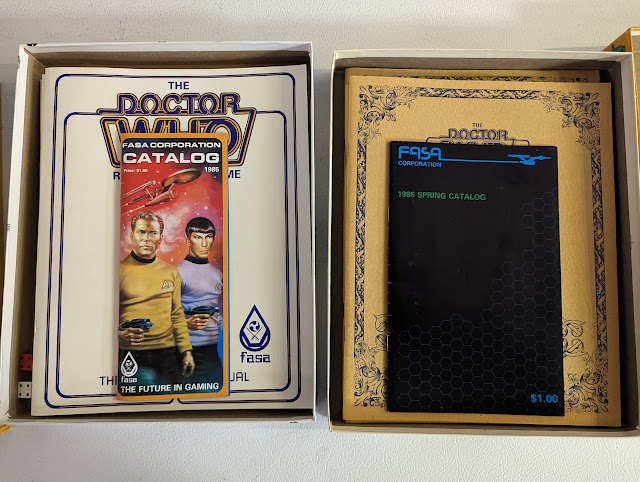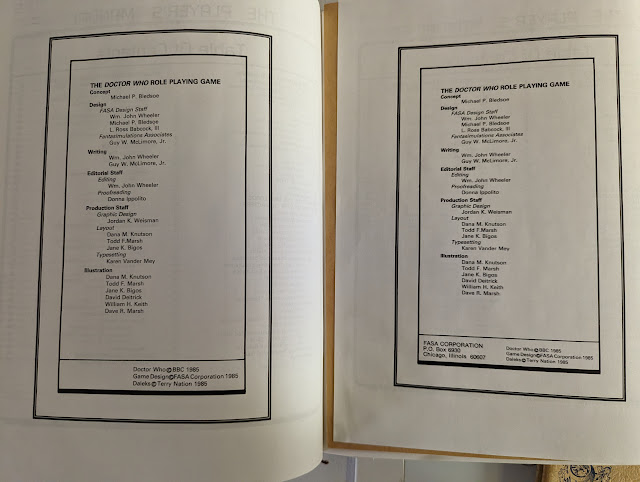As we talked about
yesterday, the Doctor Who RPG from FASA was released in 1985/6 and consisted of three books and two d6s. I'll cover each in turn.
Since yesterday I have discovered that while, yes, Colin Baker's 6th Doctor was not popular, that is not why his photos have been removed in the later printings, it was due to FASA not securing the rights to Colin Baker's (and the 6th Doctor's) images.
A few more notes. The material is a bit all over the place, as was common with many game books of that time, so you need to jump from the Player's Manual to the Game Operations Manual. Not a big deal really, but feels unneeded these days.
The books are also presented in three-column format. And in case you forget, the logo for Doctor Who is at the bottom of every page. Most of the art is either black-and-white screenshots or publicity stills from the first 25 years of the show and some art. The art varies quite a bit and a lot of it is repeated. Again, I find it hard to complain by comparing it to today's standards. Plus licenses are expensive.
The Doctor Who: Adventures in Time and Space RPG
Michael P. Bledsoe & Wm John Wheeler & L. Ross Babcock III & Guy W. McLimore Jr
FASA 9001, ISBN 0931787904
1985
Out of Print
Book 1: Player's Manual
This 48-page book focuses on introducing new players to this RPG and Doctor Who, though it seems unlikely that anyone buying this doesn't know what Doctor Who is. This also covers character creation.
Characters will be either a Time Lord from Gallifrey or a human companion. It is recommended that first time players choose a human companion. While the rules *could* adapt to other species of companions there are no real guidelines for it. But honestly human does account for at least 90% of all companions. Even "aliens" like Adric, Nyssa, and Capt. Jack. The only ones that were not human were K-9, Romana, Susan, and River.
All characters have six Attributes; Strength, Endurance, Dexterity, Charisma, Mentality, and Intuition. These would map onto the "Standard Six" pretty well. Attributes can range from 1 to 30, with human average of 6 to 10. Additionally, these scores are grouped by Performance Levels (I to VII, "Handicapped" or "Unskilled" to "Mastery"). Skills are measured the same way. Each skill is attached to an Attribute. A "Trivia" category even covers any skill not described. Some weapons are covered (largely thanks to Leela I think) but there is only a sampling. Weapons are deadly in Doctor Who.
Characters also gain a Special Ability (or more) to help set them apart. This can be things like the Master's ability to hypnotize.
Other details like personality traits, appearance, and background are then worked out.
There is a fiction section, Tabby Cats and Time Lords, that gives us a new Time Lord "Stan" short for "Alistanathcalebiviteth." Obviously using Romana as the model here. And a new companion T.C. a cat burglar. They get involved with the Master, and Stan ends up regenerating right away.
From here we get into the details on how to make characters.
Here we find that level (I to VII) grants bonus points (1 to 7) to skills. Attributes all begin at 6 and players are given 36+2d6 points to divide up amongst the Attributes. Then a 3d6 is rolled to determine what if any special abilities characters could have. Plenty of examples are given along the way.
Even looks and personality traits can be randomly determined.
There is a section on combat, but Doctor Who is not a combat-focused show nor is it a combat-focused game.
The Doctor Who game uses an Action Point system. Fairly routine these days, but it was fairly novel back then. This lets the players know what (and how many) actions they can take.
This book ends with a bit on Regeneration for Time-Lord characters.
Book 2: Sourcebook for Field Agents
This 64-page book is simultaneously fascinating and irritating. The book largely works as the "Campaign Setting" for this game. First thing first, massive credit to the authors for trying to make sense of 25+ years of Doctor Who lore that is often contradictory and lacking in proper details. The book, even as a guide to Doctor Who, is fascinating. I also get irritated at some of the liberties taken with the lore. I understand WHY they had too, and why it is needed for the game. There are similar liberties that FASA takes in the Star Trek Game. Nothing here would impact my enjoyment of the RPG or the show, but some are just odd. Example. Conflating the "Meddling Monk" with "The Master" as the same person. Something later media does not do.
Of course, some things are nowhere near the fault of the writers, either of the show or the game. For example, we never made it to Jupiter in the early 2000s (interestingly enough, the same thing is predicted by Star Trek).
The focus of this book and indeed the "buy in" from the players and characters is the involvement of the CIA or Celestial Intervention Agency. This is a group of Time Lords that do meddle in the affairs of others and keep time flowing on it's proper course. They are largely ignored by the President and High Council of Gallifrey and are said to have been created by Rassilon himself. Since they are clandestine and "off the books," CIA field agents don't get top-notch equipment. Usually, they get what ever has been ignored in the repair bays. So these TARDISes are older and often have bits still malfunctioning. It makes it easier then for Game Masters to steer them where they want.
I DO enjoy the game making Earth a "Temporal Nexus Point" within the game. While this moves the spotlight away from Earth as the Doctor's favorite planet, it does help explain why the rest of the galaxy keeps picking on us.
This book has an overview of all the creatures we have seen in Doctor Who to that point and detailed sections on some of the major creatures/aliens too. Namely the Daleks, Ice Warriors, and Cybermen. The Movellans keep getting attention here despite at that time only appearing in one serial. Since then they have only showed up as background elements in a Dalek fight. Not really on par with the Sontarans or the Silurians really if you ask me.
Lists and descriptions of tons of equipment including the famous sonic screwdriver and the Master's Tissue compression eliminator. Honest the list feels like an expanded version of the Doctor Who Technical Manual. There are broad timelines for both Earth and Gallifrey. Best just to avoid the whole UNIT timeline.
The TARDIS Operations section is still surprisingly useful, even given all the things we have seen since.
We also get some stats for all six incarnations of the Doctor along with a bio. We also get stats for 14 (or 15 if you count Romana twice) companions, with a focus on the most recent and most popular ones. Sorry Dodo and Polly.
This is the one book from this game that would still have some utility in other Doctor Who RPGs. Some minor edits would be needed to bring it in line with the modern series, but that is expected.
Book 3: Game Operations Manual
This 80-page book is the Game Master's book. One of the complaints I have read about this book is that a lot of the material in it is a repeat of material from the Player's Manual, but this is a feature, not a problem.
It covers the basics of what an adventure is, what a campaign is, and how to craft adventures for your players.
There is a good section on Judging Character Creation, which goes over the character creation options from the Game Master's point of view. While not explicitly said it lends itself very nicely to notion of a Session 0.
The leads into judging various actions and what to do. Here the Interaction Matrix comes into play a lot. Modern games would likely have a sliding target number, but this chart is wonderfully Old-School. There are also plenty of examples of what can be done at each Attribute and Skill Performance Levels (I-VII).
There is repeated content on the various alien creatures here. I did recall that at the time I wanted these to be better edited so they took up less space more more importantly having all the information in one spot, but today I am fine with it. This way the players can keep a book nearby and the Gamemaster has their own book.
We also get a lot of detail about time travel (naturally) and TARDIS systems. This in and of itself is a great read.
Overall and Closing Thoughts
I do have to hand it to the authors, designers, and the folks at FASA for trying to untangle a mass of self-contradictory histories from within the show.
The game is still very playable to be honest and has a lot going for it. I think play wise it would be far too crunchy for many modern players, especially when there is the fantastic Cubicle 7 game that is still available. But that doesn't mean you still can't use these books.
The Sourcebook for Field Agents is still a great read as a Doctor Who book, not just an RPG. And there is still good advice here for Game Masters of every sort, not just Doctor Who (whatever RPG) ones.
It is great to have this and I am looking forward to seeing what I can do with it in the future.
Still, though. Pity how the 6th Doctor was done wrong here.






























